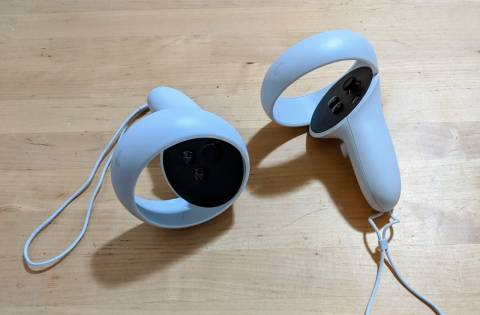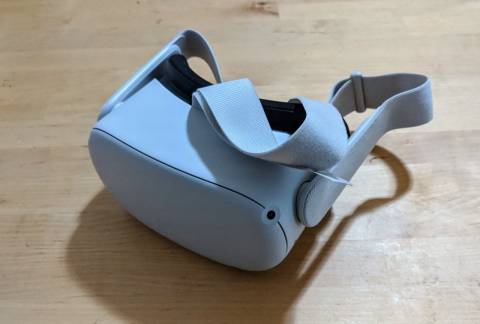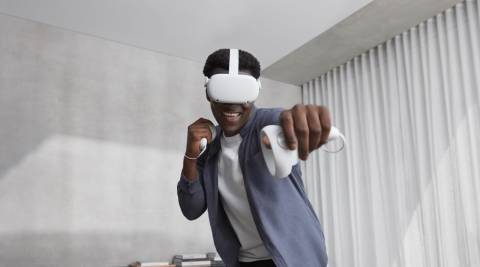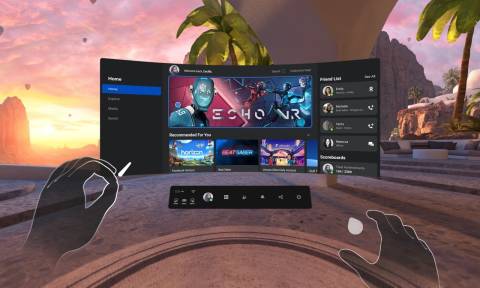Oculus tinkered with standalone virtual reality with its Go headset, but it wasn't until the Quest that the company really nailed a genuinely immersive VR experience without any cables. The Oculus Quest 2 follows in the footsteps of its predecessor, but with a more powerful processor, a sharper screen, and a lighter design. It does all of this for just $399.99 after a recent $100 bump in price, but that's still significantly lower than competitors like the $699 HTC Vive Cosmos and $999 Valve Index. Add optional PC tethering with an accessory cable, and you have a comprehensive VR system at the most reasonable price we’ve seen, earning our Editors’ Choice for VR headsets.

Design

The Quest 2 is a bit smaller and lighter than the original, weighing 17.7 ounces and measuring 4.0 by 7.5 by 5.6 inches (HWD), not including the strap. The smooth plastic chassis of the headset is white, with the plastic and foam eye mask behind it a contrasting black. The front faceplate is nearly bare, with four position-tracking cameras mounted along its edge.

The left side of the headset holds a USB-C port and a 3.5mm headphone jack, while the right side is home to the power button and an indicator LED. A volume rocker can be found on the underside of the headset, along with two pinhole microphones. The eye mask easily pulls out to let you adjust the position of the lenses, or to insert the included separator that lifts the headset slightly away from your face so you can comfortably use it with glasses. Even with the separator, however, glasses can feel awkward if you have particularly large frames.

The headband is a three-point elastic strap mounted on plastic arms that can pivot slightly up and down. The arms hold speakers that pipe sound into your ears without headphones. The top strap connects to the headset with hook-and-loop (Velcro) fasteners, letting you adjust how the top of the Quest fits against your face. The side straps connect at the back with two plastic sliding clips.

It’s fast and simple to adjust the headset with its default strap, but it doesn’t provide the most secure fit to keep it in place, and it can shift if you move your head quickly or sharply. You can replace it with the Quest 2 Elite Strap, a $49 accessory that provides a more secure fit with a ring-shaped piece of plastic that cups the back of your head, and a ratcheting wheel that keeps the strap locked in place.
Controls

The two motion controllers included with the Quest 2 have seen a slight redesign from the original Oculus Touch controllers used with the Quest and the Rift S. They’re still rounded handles with prominent rings on top for the headset’s cameras to track their position, and the two triggers still fit naturally under your index and middle fingers. The circular control surface at the top of the handle, right under your thumb, is larger than before, with a comfortable, bare spot to rest your thumb when you aren’t actively using the analog stick or two face buttons.

The new design makes the controllers feel a bit thicker in the hand and easier to hold securely, and the battery door is less prone to sliding off during intense gameplay sessions. It isn’t a drastic redesign, but a few small tweaks that make the controllers feel better without changing their layout or functions.
You can also use the Quest 2 with your bare hands. The headset supports hand tracking, a feature originally previewed in beta on the original Quest, which uses the cameras to follow the position, orientation, and shape of your hands. With the feature enabled, you can move your hands freely in front of the headset to control the in-system pointer. Pinching your thumb and forefinger together for a moment serves as a click, and pinching and holding works as a click and drag.
The hand tracking feature works well, but unfortunately it doesn’t replace the controllers for most apps. While you can use your hands to navigate the Quest 2’s menu system, you're prompted to use the controllers when launching Netflix or YouTube VR, for instance.
Hardware
Oculus has upgraded the headset's processor from Qualcomm's Snapdragon 835 to the Snapdragon 865-derived Snapdragon XR2. This is impressive in and of itself, as the Quest 2’s $300 price makes it the most affordable Snapdragon 865-based device available in North America by far (phones with the same chip sell for around $1,000). More importantly, the new processor affords a significant boost in performance over the original Quest. It also gets two more gigabytes of RAM, for a total of 6GB.
The headset launched with 64GB of storage, with no way of expanding it. However, starting August 24, 2021, the Oculus Quest 2 will feature 128GB of storage, while retaining the same price. Unfortunately, you still won't be able to expand the storage.
The display has been upgraded a great deal, as well. The headset now shows a 1,920-by-1,832-pixel picture to each eye, up from 1,600 by 1,440. At launch the Quest 2 shares the same 72Hz refresh rate as the original, but 90Hz support will be added in the near future.
Battery life remains limited, which is one of the main issues for all standalone VR headsets. Oculus says you can expect between two and three hours of use between charges, about the same as the original. It’s short, but you can double that time with the $129 Quest 2 Elite Strap With Battery and Carrying Case, a version of the aforementioned accessory strap with a built-in battery pack. It isn't cheap, but considering it and the Quest 2 together cost just $30 more than the original headset did, it isn’t that daunting if you really want long play sessions.
Oculus Store and Oculus Link
The Quest 2 uses the same in-headset menu system and store as the original Quest. This gives you access to dozens of compelling VR experiences, all accessible and tracked through your Facebook account (which serves as your Oculus account). You can access plenty of entertaining software through the store without needing to use a PC, including Beat Saber, Rez Infinite, Superhot VR, Tetris Effect, and more.
Outside of the games available through the in-headset store (of which there are many), you can also enjoy the full breadth of the Oculus PC and Steam VR stores with the optional $79 Oculus Link Cable. It’s a 16.4-foot (5m) USB-C cable designed to let you connect the Quest 2 to a compatible PC to access its VR software library. While you can probably find a cheaper USB-C cable to use, the Oculus Link Cable’s length and flexibility make it particularly well suited for use with the headset. And even by adding the price of the Oculus Link Cable to the Quest 2, you’re still paying less than the original Quest or the Rift S.
The PC tethering option is important for two reasons. First, a PC simply provides far more power than even the Snapdragon 865 processor can offer, enabling more graphically advanced VR software like Half-Life: Alyx. If you want the most advanced VR available, you need a tethered connection to a powerful computer. Second, Oculus is phasing out the Rift line of tethered headsets, so the Quest 2 will be the sole VR headset the company offers to provide both standalone and PC-tethered VR.
Performance
The Quest 2 uses the same Guardian system as its predecessor, which lets you draw boundaries around your play space so the headset can warn you if you’re about to step out of the designated area (and perhaps bump into something). It works well, remembering the specific areas you choose, or letting you set up a stationary circle for games that don’t require a lot of movement or walking around.
The head tracking remains very accurate, with the headset’s four cameras constantly scanning the area around you to determine where you are while its internal sensors track orientation. The cameras also track the controllers, which have internal sensors for motion tracking as well. It’s a full six-degrees-of-freedom (6DOF) experience, just like the original Quest, and it feels very immersive.
The higher display resolution makes a noticeable difference, with everything looking sharper than it does on the original Quest. You can still discern pixels if you look very closely, but just barely. Ultimately, the experience is much more crisp and clean all around.
I started by playing Tetris Effect, which was originally released on the PlayStation 4 and which I've enjoyed playing on the PlayStation VR. It looks and sounds great on the Quest 2, and is just as immersive and a bit sharper than on the on PS VR. My only complaint is the control scheme: Tetris requires digital precision, ideally using a direction pad like on the DualShock 4 controller. The analog sticks on the Quest 2’s controllers are a bit too sensitive, and I was prone to accidentally dropping blocks when I didn’t want to.
I then played some Gun Club VR, a shooting gallery game. The headset tracked my controller movements accurately, letting me carefully aim different firearms at pop-up targets with precision. The higher resolution helped me pick out distant targets and better align head shots, for an entertaining simulator experience.
You can also use the headset to watch YouTube in VR. It produces a simulated big screen directly in front of you, letting you watch videos as if you were sitting in a theater. It’s suitably immersive and easy to use, and again the higher resolution means the viewing experience is sharper and more pleasant.
Finally, I spent some time with my two favorite VR games, Beat Saber and Superhot VR. Superhot VR is a first-person shooter where time only passes when you move, letting you pull off incredible feats of disarming and marksmanship. The Quest 2 tracked my head and the controllers perfectly, letting me dodge bullets and pick off attackers like John Wick.
Beat Saber is a rhythm game where you slash at glowing blocks flying at you in time with the beat of a song, and again the Quest 2’s tracking was accurate. Both games looked sharp through the headset, with the 72Hz refresh rate keeping the action smooth, though I’m looking forward to the 90Hz refresh rate being enabled in the future.
The Best Gets Better
The original Oculus Quest was a VR breath of fresh air with its 6DOF head and controller tracking, strong performance, and, most importantly, standalone functionality. The Quest 2 is an upgrade in every way, with a lighter design, a sharper display, and a faster processor, all at a more affordable price than the original. For $400, it's the best all-in-one package for using VR, with optional accessories for PC tethering and to double the battery life of the headset. That makes it the best VR headset at this price by far, and our Editors’ Choice.
